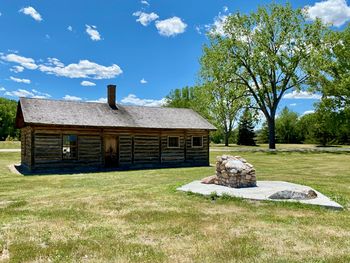Fort Robinson (1)
|
Fort Robinson (1) (1874-1948) - First established as Camp Red Cloud Agency by Colonel John A. Smith in 1874. Renamed Camp Robinson 29 Mar 1874 and Fort Robinson in January 1878 after 1st. Lt. Levi H. Robinson, 14th U.S. Infantry, who was killed by hostile Indians in Wyoming on 9 Feb 1874. Abandoned in 1948.
History First established 8 Mar 1874 in response to a Sioux Indian uprising over treaty violations by white settlers in the Black Hills. The military reservation encompassed some 36,000 acres. The post played a significant role in the Sioux Wars in Nebraska between 1876 and 1890. Indian chief Crazy Horse was captured nearby and was fatally wounded at the Fort on 5 Sep 1877. The post itself was built as an open plan fort with the buildings initially built of pine logs. The Army rebuilt the fort around a new parade ground in the 1880s. Six L‑shaped enlisted barracks were constructed with adobe bricks on the south side of the parade with a like number of officer quarters on the north side. Support buildings and other quarters were organized at the east end of the post.
World War IThe post became one of the largest remount stations in the world during World War I. Thousands of Army horses and mules were bred and trained there. The post was expanded over the years and rebuilt again in the 1920s when most of the adobe buildings were replaced with fired-brick buildings. World War IIFort Robinson retained its role as a cavalry post and remount station through the beginning of World War II and many units turned their horses as their units were mechanized. The number of horses and mules at Fort Robinson peaked at about 12,000 by 1943. In the winter of 1943-44, the Army began a series of horse sales to reduce the population but horses and mules were still required for special situations, and the need was never completely eliminated. Fort Robinson also served as a training ground for some 14,000 K-9 dogs during World War II and as a POW camp for German prisoners of war, 1943-1946. The first 680 German prisoners arrived on 19 Nov 1943. The post was declared surplus by the Army in 1948 and turned over to the United States Department of Agriculture. In 1955 portions became Fort Robinson State Park.
Current StatusFort Robinson State Park. Several period buildings survive including a 1905 Post Headquarters, an 1887 adobe officer's quarters, a 1906 blacksmith shop, and a 1909 veterinary hospital. The Nebraska State Historical Society operates a museum on the site.
Sources:
Links: Visited: 11 Jun 2020
| ||||||||||||||||||||||||||||||||||||||||||||||||||||||||||||||||||


